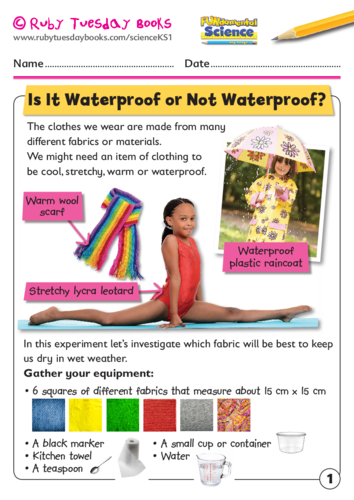
KS1 Science: Materials - Is it waterproof or not waterproof?
Carry out this waterproof/not waterproof experiment, encouraging children to predict results, record their findings scientifically in a table and answer quality scientific questioning. It complements our book ‘Everyday materials’ from our FUNdamental Science series. For more information, downloads and to purchase our books, please visit www.rubytuesdaybooks.com
This download helps meet the following National Curriculum targets:
Year 1 Science: Everyday materials
Statutory:
Distinguish between an object and the material from which it is made
Identify and name a variety of everyday materials, including wood, plastic, glass, metal, water, and rock
Describe the simple physical properties of a variety of everyday materials
Compare and group together a variety of everyday materials on the basis of their simple physical properties.
Notes and guidance (non-statutory)
Pupils should explore, name, discuss and raise and answer questions about everyday materials so that they become familiar with the names of materials and properties such as: hard/soft; stretchy/stiff; shiny/dull; rough/smooth; bendy/not bendy; waterproof/not waterproof; absorbent/not absorbent; opaque/transparent. Pupils should explore and experiment with a wide variety of materials, not only those listed in the programme of study, but including for example: brick, paper, fabrics, elastic, foil.
Pupils might work scientifically by: performing simple tests to explore questions, for example: ‘What is the best material for an umbrella? …for lining a dog basket? …for curtains? …for a bookshelf? …for a gymnast’s leotard?’
Year 2 Science: Uses of everyday materials
Statutory:
Identify and compare the suitability of a variety of everyday materials, including wood, metal, plastic, glass, brick, rock, paper and cardboard for particular uses
Notes and guidance (non-statutory):
They should think about the properties of materials that make them suitable or unsuitable for particular purposes and they should be encouraged to think about unusual and creative uses for everyday materials. Pupils might work scientifically by: comparing the uses of everyday materials in and around the school with materials found in other places (at home, the journey to school, on visits, and in stories, rhymes and songs); observing closely, identifying and classifying the uses of different materials, and recording their observations.
Something went wrong, please try again later.
This resource hasn't been reviewed yet
To ensure quality for our reviews, only customers who have downloaded this resource can review it
Report this resourceto let us know if it violates our terms and conditions.
Our customer service team will review your report and will be in touch.
